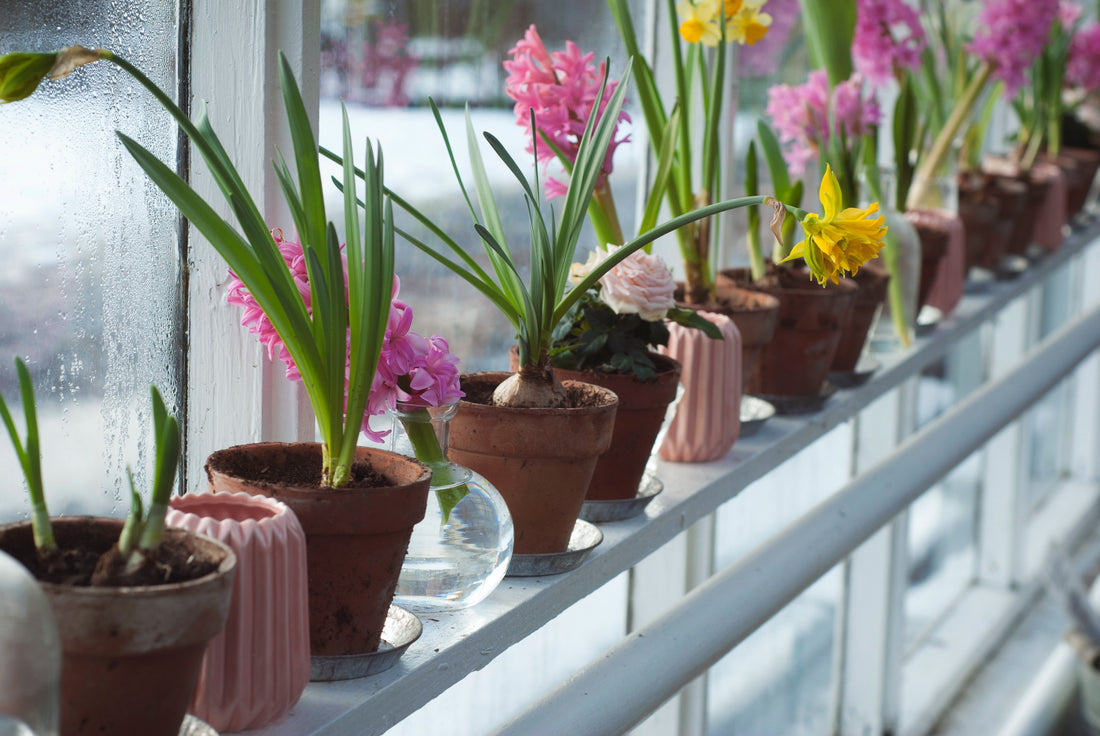
How to Force Bulbs for Indoor Winter Blooms
Share
Yes, you can have blooms in the winter. Forcing bulbs is a way to trick spring-blooming flowers, like crocuses, tulips, and hyacinth, into thinking it's spring. Forcing bulbs is easier than you probably think--follow the steps below to have spring blooms even during the throes of winter.
First: A Bit About Bulbs
Spring-blooming bulbs actually need a dormant period in order to bloom. If planting outside, we recommend planting the bulbs after the first frost, when soil temperature stays consistently below 60°F. This chilling period essentially shuts the bulb down until soil temperatures warm up and signal the plant to start blooming.
When forcing bulbs for indoor blooms, you are mimicking the natural process of chilling and warming to shut the bulb down and then signal it to flower.
Step 1: Choose Your Bulbs
Pick spring-blooming bulbs. We prefer to use bulbs that need a shorter chill period, like crocuses, muscari (grape) hyacinth, and squill. Below are the chill periods needed for different bulbs:
- Muscari Hyacinth: 6-8 weeks
- Anemone (windflower) 8-10 Weeks
- Crocus: 10-12 weeks
- Squill: 10-12 weeks
- Allium: 10-12 weeks
- Tulips: 14-16 weeks
- Daffodil: 16-18 weeks
The chill period is the length of time that these bulbs need to be kept between 32° and 40°F--a refrigerator, garage, or unheated basement will work well.
Step 2: Choose Your Pot
Since you are forcing bulbs indoors, you have more choice in what material the pot is made of. As long as temperatures do not get below freezing, terracotta, ceramic, and rigid resin pots will work fine.
The size of the pot will depend on the number of bulbs and types of bulbs you plant. Read the instructions on your bulb packaging to determine planting depth. Choose a pot that will allow at least 3-4" of soil depth under the deepest-planted bulb. Bulbs can be planted close together, but not touching.
Step 3: Choose Your Potting Soil
Bulbs are susceptible to rot, so choose a potting soil that is light and offers plenty of drainage. We love Espoma Potting Soil and Pro-Mix Potting Soil, as they both have beneficial nutrients to feed the plants and are light enough to allow great drainage in pots and containers.
Step 4: Plant Your Bulbs!
Here it is. The moment you've been anticipating. Fill the bottom 3-4" of the pot with soil. Gently place the largest flowering bulbs on the bottom, with the pointed end of the bulb facing upward. Bulbs can be planted closely, but keep them from touching.
Layering bulbs is a great way to ensure you'll have blooms all season long. Place larger bulbs near the base of the container, and smaller bulbs toward the top. You can leave the tops of the bulbs exposed.

Step 5:Chill
As mentioned above, spring bulbs need the winter chill in order to bloom. Place your bulbs in a cool, dry place that stays between 32°-40°F. An insulated garage, a basement, or a refrigerator will work well.
A word of caution: Do not store your bulb container in a garage where cars are left idling or in a refrigerator where fruit is stored. The ethylene gas released by cars and fruit can inhibit flower growth.
Use the chilling periods above to determine how long bulbs need to be chilled.
Be sure that soil is kept moist but not wet for the duration of the chill period.
In the last 1-2 weeks of the chill period, check for root development. You may see white fleshy roots beginning to make their way out of the pot, or you can gently feel around in the soil to ensure roots are developing.
Step 6: Warm Up & Enjoy the Blooms
Once you've confirmed you have good root development, you can remove the pot from the cool storage. Place it near a window in a room that stays around 65°F. Bright lighting creates more compact and abundant flowers.
Wait 2-5 weeks. You'll see greenery emerge before then, but blooms will start emerging after a few weeks. Bulbs needing a longer chill period will bloom last.
Step 7: Save Your Bulbs
If you want to save your bulbs, we recommend planting them outside once the threat of frost has passed. Keep bulbs healthy by watering and keeping them in a bright area. It can be difficult to re-force bulbs the following year, we recommend using new bulbs each winter and planting the forced bulbs in the ground in the spring.
As always, if you have any questions or need advice, our helpful crew at Mandy's Spring is always happy to assist. We are open 9AM-5:30PM Mondays-Saturdays.


